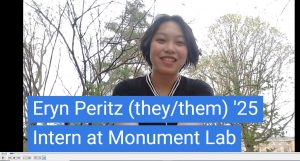Bringing Fleisher’s Past to the Future: Digitizing their Artistic Archives!
Semester: Spring 2023
Praxis Course: HART 420 Museum Studies Fieldwork Seminar
Faculty Advisors: Matthew Feliz & Monique Scott
Field Site: Fleisher Art Memorial
Field Supervisors: Bailey Dodds & Catherine Lee
Praxis Poster:
NEW_KeylaBenitez_FinalPraxis Poster_rez
Further Context:
The Samuel S. Fleisher Art Memorial, located in South Philadelphia, has provided art education and cultural programming accessible to all since 1898. As part of their commitment to accessibility and inclusion, they have initiated a project to digitize their creative archives and bring Flesher’s past to the future. The project’s primary goal is to identify historically significant documents and methods for digitization. I worked with Bryn Mawr’s Archivist and Digital Collections and Metadata Librarian to develop digitization and outreach strategies that are effective and sustainable.
The project’s social justice lens means that the digitized archives will be accessible to everyone, regardless of their abilities or background. The project also created a preservation plan for a 116-year-old scrapbook created by Samuel S. Flesher himself. The scrapbook provides unique insight into the founder’s vision for the institution, its early days, and the founder’s life. However, the scrapbook is deteriorating due to its age and delicate nature. I worked to develop a plan to protect and preserve the scrapbook for future generations.
The project serves as a reminder of the vital role that institutions like the Flesher Art Memorial play in promoting community engagement. By digitizing historical documents and making them more accessible and inclusive, Flesher is preserving its history and making it available to a broader audience. This highlights the importance of accessibility and inclusion in safeguarding cultural heritage and fostering creative spaces welcoming to everyone.
In conclusion, an important initiative is for Flesher to digitize its artistic archives and bring Flesher’s past to the future. The project’s commitment to accessibility and inclusion is crucial in preserving cultural heritage and making it available to everyone. The project also demonstrates the Flesher Art Memorial’s ongoing commitment to its mission and the people of
Philadelphia.

